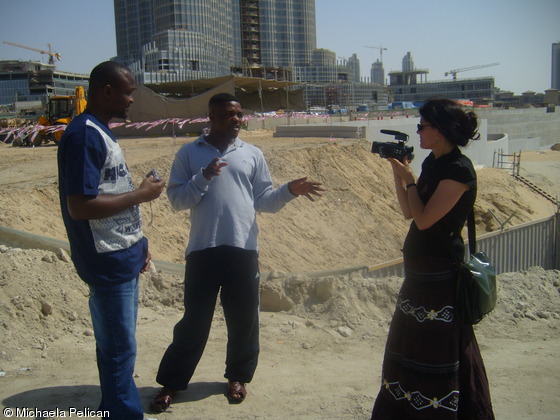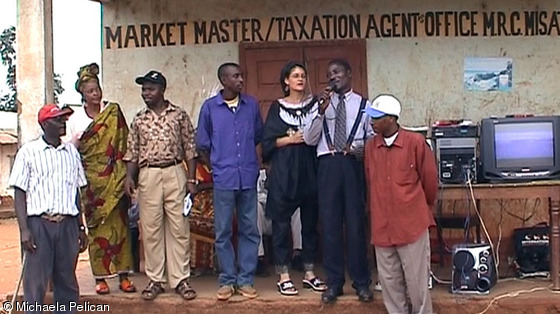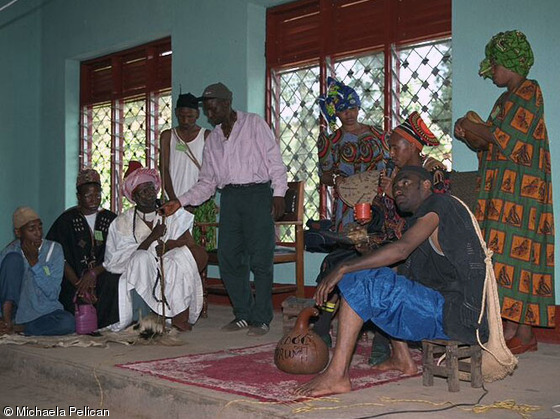Visual and Media Anthropology, Research Methodology
Visual and media anthropology has informed my research in many ways. In my understanding, the transitions between using media as a source of information, a tool to engender participation and a means of representation are fluid. From the start, qualitative-explorative methods have been part of my methodology. Among others, I have made use of role-playing, video documentation, and public film screenings. I have applied them in conjunction with standard anthropological methods and with the aim to generate additional insight to specific research questions. These methods include a strong participatory element, which I believe is one of their particular strengths. Giving the opportunity to our collaborators to express their views and experiences in various ways, to bring to the fore the subjects they consider relevant, and to actively intervene in our research, may produce surprising and illuminating insights. Moreover, it renders the research a shared enterprise.
Currently, I am interested in the ways African migrants have been represented in the Chinese public, in particular in the context of documentary photography. While being a Fellow at the Morphomata International Center for Advanced Studies (2018/19), I have worked on the project 'Recognition and alterity in the portraiture of Chinese-African encounters in Guangzhou' which links my interests in migration, ethnicity, and visual anthropology. The idea originally evolved from my earlier collaboration with the Chinese photographer Li Dong with whom I have organized the photo-exhibition BAOHAN Street: An African Community in Guangzhou, shown at the University of Cologne in October/November 2014 (see also exhibition catalogue). In the meantime, I have expanded my project to include the works of the photographers/artists Daniel Traub and Michael MacGarry who - similar to Li Dong - have documented the presence of African migrants in Guangzhou roughly around the same time (between 2012 and 2015). The goal is to produce a multivocal ethnography of the photographers' engagement with the subject of African-Chinese encounters.
In 2018, Prof. Dr. Birgit Mersmann and I invited the photographer Daniel Traub and the curator and researcher Mi You to engange in a dialogue between theory and praxis, and to discuss with us the subject of Chinese-African encounters at the Morphomata International Center for Advanced Studies.
Face To Face (short documentary, 2008/09)

When researching transnational relations of Cameroonian migrants, I adopted a somewhat interventionist approach by proposing the exchange of video messages between migrants and their relatives back home. Many welcomed the idea and spoke to the camera to inform the addressee about the latest happenings and to express their encouragement or concern. Trailing the migrants' paths, I brought to them the message from home, and in exchange carried back their stories.
At a later stage, I used part of this footage to put together a short documentary on the intimacies and challenges of long-distance communication. "Face to Face" is set primarily in Cameroon, but also takes place in Dubai, Libreville and Geneva. As the exchanges develop, we gain insight into the conflicts and affections of the individual participants, as well as some understanding of their perceptions of their places of relocation. Our stories include those of Hamme and his grandmother Hadi who have not communicated face to face for the past five years. While Hadi is expressing her concern and longing for her grandson, Hamme is telling about success, drawbacks, disappointments, hope, and police corruption. But not all exchanges are as harmonious. Sali and his four wives are mad at their younger brother for neglecting his elderly parents...
For many migrants, being part of two worlds - two different realms of experience and practice - can have a highly alienating effect. By way of experiencing both worlds and mediating the communication between them, I have gained an idea of the asymmetries and misconceptions that challenge their relationship as well as of the imaginative capacity and mutual trust that are required to make these long-distance negotiations work.
Please watch the short documentary and read the accompanying document:
Face To Face: Cameroon - Gabon - Dubai - Geneva. Short documentary by Michaela Pelican, 8 min, English subtitles
Pelican, Michaela and Billy MacKinnon. 2009. Face to Face: Synopsis and characters 
Misaje Film Festival (2001)

In my research on interethnic relations and identity politics in northwest Cameroon, I used the video-camera to document cultural activities and public events. Eight months into the research, my local collaborators and I organised a public screening of a cross-section of the edited footage. This screening was extremely well received. Besides entertaining the audience, it helped to render comprehensible the objectives of my research and to attract the interest and participation of many more interlocutors.
Together with my research assistant Ngeh Jonathan, I compiled a report on the public screening that gives an overview of the events and highlights the audiences' responses:
Pelican Michaela and Jonathan Ngeh. 2001. Report: Misaje Film Festival 26-28th October 2001. 
Theatre for Development (2000-2002)

In the 1990s and 2000s Theatre for Development became a popular tool used by non-governmental organisations operating in northwest Cameroon. As their work partly coincided with my research, I decided to benefit from their theatre activities and the population's familiarity with role-playing. In the course of fourteen months, I witnessed and partly participated in fifteen role-plays performed by members of local women's groups, youth groups, a regional non-governmental organisation and an informal drama group of which I was a founding member. These role-plays covered an array of topics, ranging from marital issues to interethnic tension, the benefits of Islamic education, the opposition of 'traditional' beliefs and Western education, and the conundrum of anthropological research. Some of the plays were videotaped, edited, and later screened during the Misaje Film Festival.
Here I want to introduce two role-plays that have been particularly informative with regard to my research. One was performed by the regional non-governmental organisation Ballotiral and deals with strained relations between farmers and herders in northwest Cameroon. The second was enacted by a group of Mbororo women who reflected on their experiences of selling milk products. Both address the subjects of ethnicity and conflict, and give us an idea of how local actors deal with cultural difference and make use of play and satire to challenge cultural norms.
Farmer-herder conflict, role-play of the Ballotiral staff.
Nkambe 29/01/2001, 2:46min., with English subtitleshdl:10681/00-0000-0000-0000-0025-C: High Quality Video accessible here (right-click, save target as ...)
Sippoigo (selling milk), role-play of the Mbororo women's group of Chako.
08/04/2001, 4:27min., with English subtitleshdl:10681/00-0000-0000-0000-0023-9: High quality video accessible here (right-click, save target as ...)
A detailed analysis of the role-plays is provided in:
Pelican, Michaela. 2006. Getting along in the Grassfields. Interethnic relations and identity politics in northwest Cameroon. Halle, Saale: Universitäts- und Landesbibliothek Sachsen-Anhalt. Chapter 6.4.2.1., pp. 227-241; Appendix E, pp. 536-540.
Further projects
Getting along in the Grassfields: Aspects of village life in Misaje (North West Cameroon). Documentary film by Michaela Pelican and Judith Orland, 2002, 38 min., English subtitles. hdl:10681/00-0000-0000-0000-002A-0: High quality video accessible here (right-click, save target as ...)
Supplementary material:
Commentary to the documentary 'Getting along in the Grassfields'
Treatment to the documentary 'Getting along in the Grassfields'
anibaara - von Stolz und Mühe, Arbeit in Afrika. Exhibition, co-organised under the supervision of Till Förster, IWALEWA-Haus, May 2000 to January 2001, Bayreuth.
Press release accessible here.